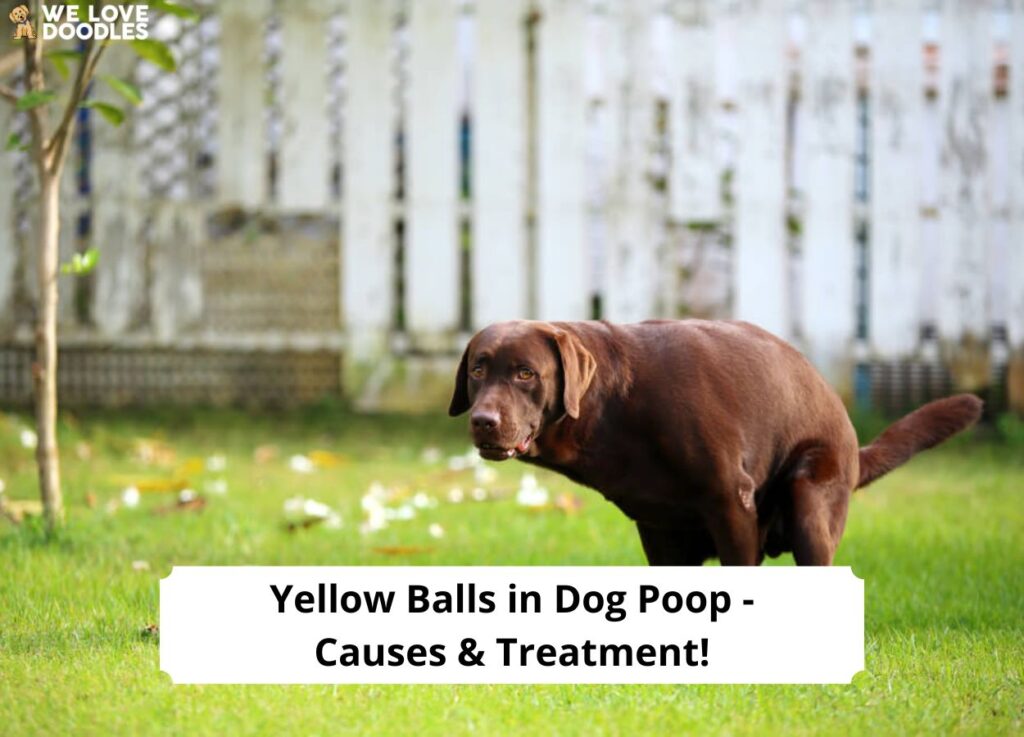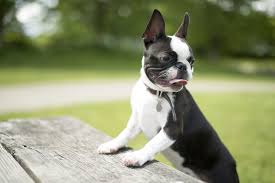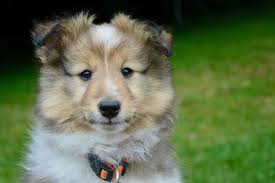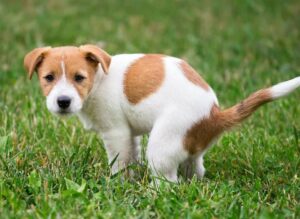
Finding yellow balls in dog poop can be concerning for anyone with a lovable pet. Sometimes, these yellow balls may mean your dog has eaten something it shouldn’t, like toys or trash. Other times, these yellow balls indicate more severe issues, like tapeworms.
Thankfully, there are some simple explanations for why you might find yellow balls in dog poop. When you can figure out what’s causing the problem, it’s easier to stop it and make your pup more comfortable.
If you can’t figure out the problem or find a solution with this guide, take your dog to your veterinarian for further assessment immediately.
Before you read a more in-depth answer to this guide, “Yellow Balls in Dog Poop – Causes & Treatment,” check out: Dog Poop Encased in Membrane – What Does This Mean? (2023) and Why Is My Dog’s Poop Grainy? Common Reasons! (2023).
What Are the Yellow Balls in Dog Poop?

Before you panic about finding yellow balls in your dog’s poop, know that there are some simple explanations that you can easily remedy. Those yellow balls could be something they couldn’t digest or something that requires medical attention, but it’s typically treatable.
Tapeworms
While the above issues can resolve on their own with dietary changes, there is one common issue that requires a trip to the vet. Those yellow balls could be due to tapeworms, parasites that can cause a lot of discomfort, leaving your furry friend malnourished and unhappy.
Tapeworms will usually lay eggs in your dog’s intestines and stool that will resemble seeds or grains of rice, making them easy to spot. Those yellow balls could be segments of tapeworm, and you might find more around your dog’s anus or in their bed.
Though tapeworms aren’t typically dangerous for dogs, it sounds gross and concerning. However, tapeworms are treatable with medication from your veterinarian.
Note that it’s likely you will notice other symptoms if your dog has tapeworms, so watch for other changes. Aside from yellow balls in their poop, you might notice diarrhea, vomiting, and bloating. They might eat less or stop eating and become lethargic.
Toy or Shoe Pieces

Dogs are famous for their love of chewing on and eating everything in sight, including yellow things that their bodies cannot digest. Aggressive chewers or those who easily tear through shoes and other household items may suffer the most with the digestive process.
For example, if your dog gets their paws on a pair of shoes, you may find them pooping chunks of the shoe soles or fabric. Additionally, if you have children, your dog may have gotten a hold of a doll or other toy and is now pooping out toy chunks.
Plant Material
Dogs love rolling around in the garden. Some of the plant material in the neighborhood or your own backyard can pose a hazard to your dog’s overall well-being and health. Consider putting up a fence to other barriers to keep them from plants if your dog refuses to stop chewing on random plants.
If your dog chews on plant material, you’ll likely find a wide range of colors and chunks in their stool, including leaves and seeds. Look at your dog’s poop to see if there are any green parts or leaves along with yellow balls.
These other colors can help you narrow down the cause of the yellow balls and help you decide which parts of the garden should be removed or blocked off.
Corn

Dogs can eat corn in moderation without issue. However, you may notice chunks of corn in your dog’s poop if they eat too much because their bodies can’t break it all down. Instead of being dissolved in the stomach and intestines, you might find pieces of corn shells in their poop.
Thankfully, corn in your dog’s poop is one of the easiest things to spot since a kernel or shell is identifiable compared to other options.
Undigested Fat Particles
When dogs eat high-fat diets, like bacon and scraps from your meal, they might not be able to digest it properly. Dogs cannot handle an overabundance of fatty or greasy foods, and it can lead to a more serious health condition.
Feeding your dog too much fatty food can lead to weight gain and low energy. Their body struggles to process the excess fat and it comes out in their stool in concentrated balls. Ultimately, dogs can develop pancreatitis, which can prove fatal.
Treatment for Yellow Balls in Dog Poop

Figuring out what’s causing those nasty little yellow balls is only half the battle. Once you determine the cause, you need to know how to fix it, and in some cases it just takes time.
Wait It Out

For many of these causes, you just have to wait for your pup to pass all of the bits. Corn, toys, plants, and other foreign objects might just take time to work through your dog’s digestive system.
Keep a close eye on your dog’s behavior and look for signs of something worse, like abdominal distention, loss of appetite, lethargy, or whining in pain for no reason. You might also notice your dog dragging their butt across the floor, which could indicate a deeper issue.
Change Your Dog’s Food
If you have been feeding your dog corn-heavy or high-fat meals and snacks, it’s time to change their diet. Here are some tips:
- Choose low-fat food for your dog’s daily meals.
- Avoid corn-based dog foods to limit the amount of corn they get and ease the stress on their digestive system.
- You also need to stop feeding them scraps from your plate to reduce the amount of greasy bits they ingest.
- Look for foods that use no artificial colors because while those dyes are common, they are often carcinogenic and can cause some canine cancers.
Shifting the way your dog eats may not be easy because they develop a taste for high-fat, high-flavor foods just like humans. Making the switch to a healthier option might take time and encouragement.
See a Veterinarian

There may come a point when neither of these approaches resolves your dog’s issue, or they develop new symptoms. Take your dog to the veterinarian for additional testing to determine the right treatment path.
Preventing Yellow Balls in Dog Poop

Prevention is a better option than treatment, but any dog parent can tell you that it’s impossible to keep a pup out of everything. Between chewing on toys and shoes to getting into fields, dogs can swallow all kinds of things that give their digestive tract problems. They can even swallow part of a corn cob whole.
With these tips, you can help keep your dog safe:
- Do your best to watch what they chew and eat to prevent them from ingesting something harmful.
- Feed them a healthy diet that’s low in fat and avoid offering greasy scraps.
- Check your pup’s poop regularly for signs of anything irregular, like yellow balls.
- Maintain regular grooming habits to watch for fleas that can carry parasites, like tapeworms.
- Make sure your dog is dewormed regularly and takes medication to prevent them.
- Don’t let your dog roam freely where they can get into trouble and eat things you could never begin to guess at.
The most important step to take to prevent issues with your dog’s stool is to keep up with regular check-ups. Your vet can spot warning signs early and treat them faster and more efficiently.
Frequently Asked Questions

These answers can help you decide what to do next if your dog has digestive issues.
There are a few reasons your dog may have yellow balls in their poop, including toy pieces, plant material, or tapeworms. Use a stick or twig to inspect the yellow balls to help identify the underlying issue.
Pea-sized balls in your dog’s stool may be tapeworm eggs or pieces of their food that went undigested, like corn shells or plastic bits.
Dogs swallow corn kernels whole and have trouble digesting the pieces, so it’s likely your dog is pooping out the kernels. Other potential causes could be tapeworm eggs or other foods your dog struggles to digest.
Your dog may poop little balls for other reasons, including a lack of fiber or water. Consider feeding your dog more kibbles and less wet food to increase their fiber. Adjust your feeding pattern as needed to help them pass stool easier.
Worm eggs look like little circles or balls in your dog’s poop. These circles likely have a transparent or yellow hue.
Parvo poop smells sweet but rotten, a lot like rotting fruit. It can be so strong it can make you gag if you come within a few feet of the stool.
Parasites present differently in dog poop depending on the type. Some might look like pasta or noodles, while others may be small and look similar to seeds or grains of rice.
Conclusion for “Yellow Balls in Dog Poop – Causes & Treatment”

Finding yellow balls in dog poop may be a scary experience for many dog owners who fear for their puppy’s physical well-being. Try not to panic if you notice something odd as this issue is easily resolved in most cases.
For many dogs, the problem simply requires waiting for the issue to pass. Others might require dietary changes to avoid excess corn and fat. Some cases, like if there’s a parasite, will require a visit to the veterinarian and some medication.
If you find this guide, “Yellow Balls in Dog Poop – Causes & Treatment,” helpful, check out:
- How to Massage A Dog to Poop! (2023)
- Why Is My Dog’s Poop Cold? Causes and Treatments! (2023)
- Why Does My Dog Walk Around and Poop? (2023)
Learn more by watching “9 Colors And Types Of Dog Poop You Should Never Ever Ignore” video down below:
Garrett loves animals and is a huge advocate for all Doodle dog breeds. He owns his own Goldendoodle named Kona. In addition, he volunteers at the Humane Society of Silicon Valley, where he fosters dogs and helps animals. Garrett enjoys writing about Doodles and believes that dogs can teach humans more about how to live than humans can teach a dog.
Why Trust We Love Doodles?
At We Love Doodles, we’re a team of writers, veterinarians, and puppy trainers that love dogs. Our team of qualified experts researches and provides reliable information on a wide range of dog topics. Our reviews are based on customer feedback, hands-on testing, and in-depth analysis. We are fully transparent and honest to our community of dog owners and future owners.